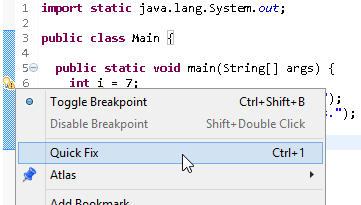

- #USING CTRL + SPACE FOR MAIN IN ECLIPSE ON MAC HOW TO#
- #USING CTRL + SPACE FOR MAIN IN ECLIPSE ON MAC PC#
- #USING CTRL + SPACE FOR MAIN IN ECLIPSE ON MAC PLUS#
- #USING CTRL + SPACE FOR MAIN IN ECLIPSE ON MAC WINDOWS#
" adds a character from the current match, so this mapping will " for the popup menu (present when doing completions). " This is a variation on the previous mapping that additionally checks " and only changes the function of in regular vim. " This is a variation on the previous mapping that checks for evim " Pressing Ctrl-L leaves insert mode in evim, so why not in regular vim, too. " Press i to enter insert mode, and ii to exit. " (and to make it where order doesn't matter, the second mapping also) " If want to avoid jk in certain languages can use:

" normal mode, you (usually) don't accidentally move: " Can be typed even faster than jj, and if you are already in vimrc be careful to not put any comments after it, imap will try to interpret the blank spaces after producing random jumps after entering normal mode.įor a better solution without visual distraction, you can consider using. If you are considering putting this map in your. The pause is merely a visual distraction which you may not notice, and it does not slow down typing.įor simplicity, we will show :imap but careful Vimmers are in the habit of using :inoremap which does not attempt to interpret the result of the mapping (with the :imap command, the result is scanned to see whether it contains another mapping). :help 'timeout'Ī problem with mapping a sequence like jj is that Vim will pause whenever you type j in insert mode (it is waiting for the next key to determine whether to apply the mapping). To generate Escape, jj has to be typed quickly. The :imap command is used to create the mapping so that it only applies while in insert mode (but see note about :inoremap below).įor example, the following allows you to press jj to exit from insert mode: (or jk, kj, etc) It can be convenient to use a mapping so that pressing a key, or sequence of keys, generates Escape. Thus using vim via a terminal gives you these short cut powers on any stock standard system without the need to edit each systems vim mappings.

For Xterm you can ctrl+click and select the option "Meta sends escape" or "Alt sends escape". The terminals konsole and gnome terminal send the escape by default when you press alt/meta+normal_mode_key. Most terminals send an escape character followed by the normal_mode_key that you pressed, removing the need to press escape yourself. If you use Vim in a terminal, simply press alt/meta+normal_mode_key.
#USING CTRL + SPACE FOR MAIN IN ECLIPSE ON MAC PC#
:help i_CTRL-C Use Alt/Meta In a Terminal Īlt keys appear on most PC keyboards. If you have a keyboard where the bracket is already mapped to Alt Gr-something (like the spanish keyboard), press Ctrl-c to quit insert mode (however, Ctrl-c does not expand abbreviations). This provides an easy way to exit from insert mode.
#USING CTRL + SPACE FOR MAIN IN ECLIPSE ON MAC PLUS#
If you have an American English keyboard, pressing Ctrl-[ (control plus left square bracket) is equivalent to pressing Esc.
#USING CTRL + SPACE FOR MAIN IN ECLIPSE ON MAC WINDOWS#
For other suggestions involving mapping keys with the operating system or utilities, see Map caps lock to escape in XWindows (for Unix-based systems), Map caps lock to escape in Windows (for Windows), or Map caps lock to escape in macOS.

No utility programs or operating system tweaks are required for this tip. Many touch typists appreciate the fact that they can leave their hands on the keyboard home row while using Vim, so there are several ideas for avoiding the Esc key at its current location (pressing Esc generally requires stretching to the top of the keyboard). The Vi editor was originally written on an ADM-3A terminal, which had the Escape key positioned where the Tab key occurs on most modern keyboards.
#USING CTRL + SPACE FOR MAIN IN ECLIPSE ON MAC HOW TO#
This tip discusses how to exit from insert mode without needing to press Esc.


 0 kommentar(er)
0 kommentar(er)
